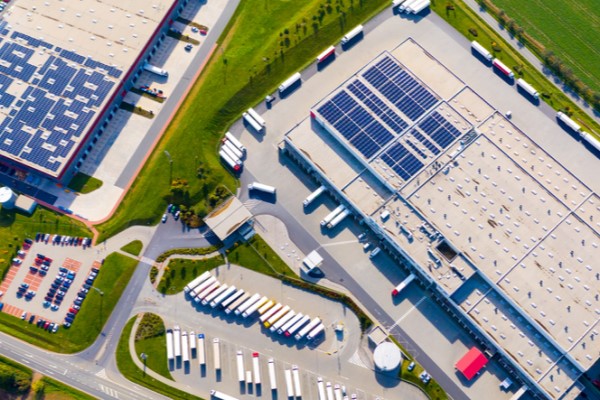Hectares of empty factory and warehouse rooftops are the solution to renewables expansion
A major barrier to renewable energy expansion in Australia is the strong opposition from rural communities who fear the takeover of arable land by solar farms, wind turbines and transmission pylons, all to satisfy the needs of EV-driving city dwellers.
Critics also cite infrastructure costs to connect a myriad of renewable sites to the grid and the inefficiencies that a decentralised system creates – the further electricity travels, the fewer electrons reach the end user.
ADVERTISEMENT
While some of these concerns are rooted in reality, the truth is Australia needs to find more ways to generate renewable energy closer to consumers and industry, and it has to happen now.
Experts at global consultancy, Partners in Performance, say that an opportunity being overlooked is the vast amount of unused commercial rooftop and car parking space in outer urban areas, at warehouses, freight and logistics hubs and factories.
September’s 2024 Electricity Statement of Opportunities, the annual ten-year outlook for the National Electricity Market, produced by grid operator AEMO, warned more attention had to be paid to consumer energy resources (CERs).
CERs include residential and commercial rooftop solar and batteries – to ensure power system security is maintained.
Australian Industry Group chief executive Innes Willox was reported saying the AEMO report showed there would be serious power shortfalls this decade and called for a sustained national effort to speed up planning, approval and delivery of new energy infrastructure.
To achieve this, we must look beyond the best puff of wind or patch of solar and find places to build more batteries and solar close to readily achievable connections. In some suburbs experiencing a lot of curtailment a step up in storage devices is needed to harness the green energy currently wasted.
Australia is famous for its urban sprawl. There are many large car parking lots and roofs in urban areas – and we can fit them with solar connected to batteries and the grid. This is much more tractable, both in terms of the bite size and the cost per unit of generation capacity.
It would be an efficient use of space, generate revenue for rooftop owners, and cut transmission costs for everyone.
Factories and warehouses typically have large, flat roofs that are ideal for solar panel installations. These roofs are rarely overshadowed by trees and other buildings, making them highly suitable for generating solar energy. Many industrial and logistic sites also have a little bit of spare space where batteries could go. Some batteries of up to 8MW can now fit into four car spaces (think of a 20ft container with extra space around it to distribute the weight). And the essential ingredient: connection sizes. Industrial sites have larger connections than homes. This is essential for faster roll out of batteries – in some Australian regions’ connection upgrades can take anything from one-to-three years.
Generating electricity on-site improves energy security by reducing dependence on the grid, and pairing it with batteries can mitigate the impact of power outages or fluctuations as well as reduce energy costs for businesses.
Collectively, rooftop solar is the second largest source of renewable electricity generation in Australia (behind wind energy generation), and the fourth largest source of electricity generation, making up approximately 11.2% of the country’s installed capacity for power supply.
The State, Territory and Federal energy and climate change ministers recently released the National Consumer Energy Resources Roadmap, reporting that one third of Australia’s households have installed rooftop solar. Total capacity of rooftop solar across Australia amounted to 22.6GW in May 2024, more than seven times that of a decade earlier.
Nevertheless, total installed rooftop solar and other distributed solar capacity in the National Electricity Market is required to reach more than 36GW by 2029-30 under AEMO’s 2024 ISP Step Change Scenario.
Adding to the challenge, is the difficulty predicting how much energy will be required across the entire grid by then.
AEMO’s 2024 Electricity Statement of Opportunities recently cut its forecast for the take-up of electric vehicles by one-third over the next decade, as more motorists buy hybrid cars, reducing pressure on the grid.
The grid operator now expects power usage from the grid to grow by 1.9% per annum over the coming decade, rather than the 3% predicted just a year ago.
The increasing size of rooftop household solar systems installed by households helped reduce the forecast.
Energy Users Association of Australia chief executive Andrew Richards, has reportedly described these forecasts as “a little like astrology”, because it is difficult to predict future demand for Chinese EVs, while anticipated strong growth in demand from data centres and households switching from gas to electricity, further clouds the picture.
Early indications are that businesses are heeding the call and see real value in fitting PVCs to their premises and/or grounds.
According to a 2023 report by fintech, Smart Ease, the commercial solar market is seeing a surge, particularly in the 15-30kW segment, with a growing preference for smaller commercial systems in the 10-15kW range.
Queensland and NSW are leading the charge, with the 15-20kW and 95-100kW segments dominating the market, collectively accounting for 55% of recent installations.
30kW of solar generation can typically fit onto the combined roof space of two average houses (100 to 250m²). A big box warehouse (50,000 to 100,000m²) can install more than 8MW, the equivalent of powering 1,500-plus homes.
Partners in Performance have assessed renewable assets for over 300 sites. Adding batteries and EV charging to solar can boost savings by 10-50% for some industrial and warehouse owners.
Whatever Australia’s power needs over coming decades, every effort must be made to maximise sources of renewable energy and this means utilising large areas of vacant space that can be fitted with power generation and storage close to businesses and consumers.
Using large commercial roof space, car parking spaces and existing connections improves business owners’ bottom lines and ESG credentials.
-
ADVERTISEMENT
-
ADVERTISEMENT


